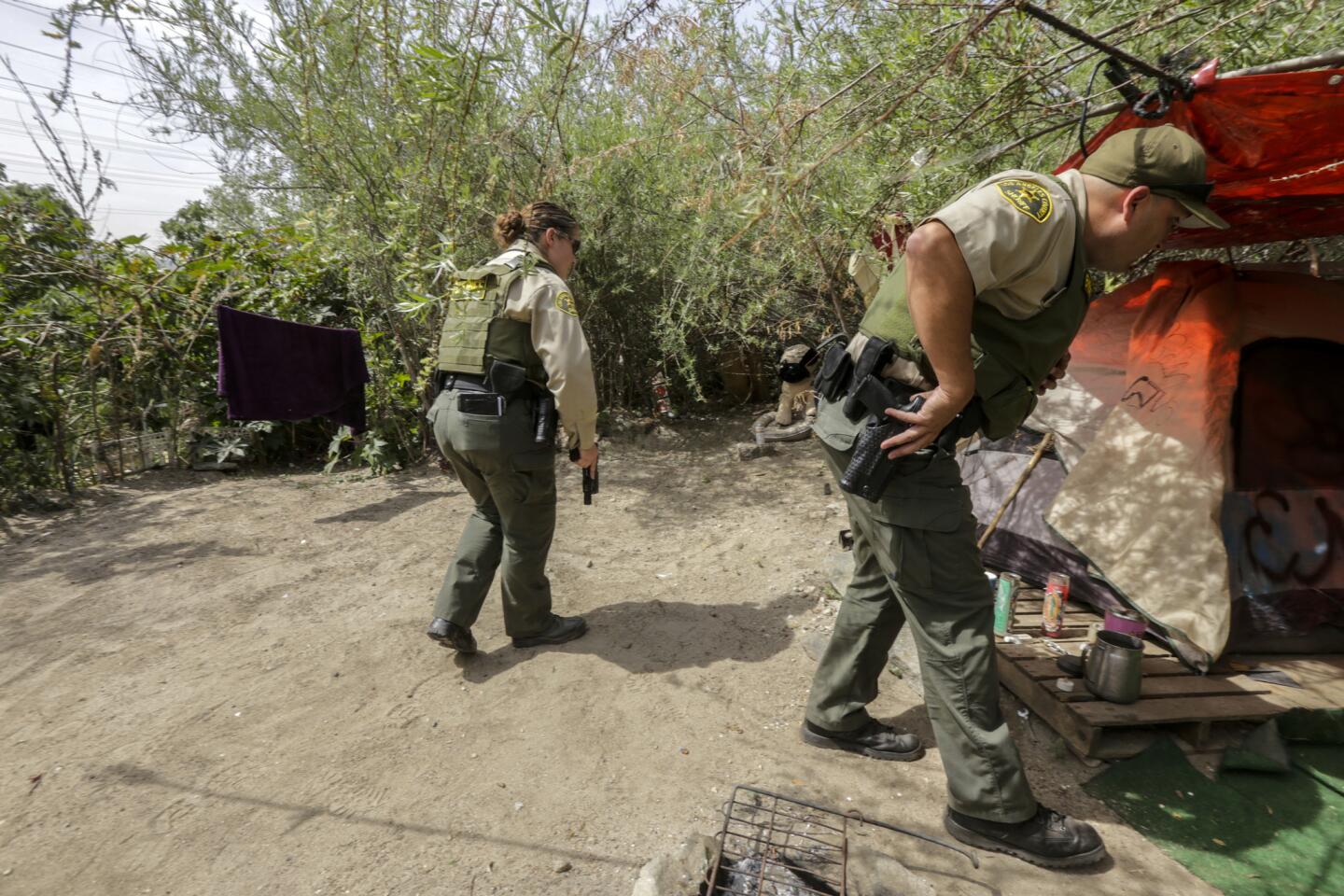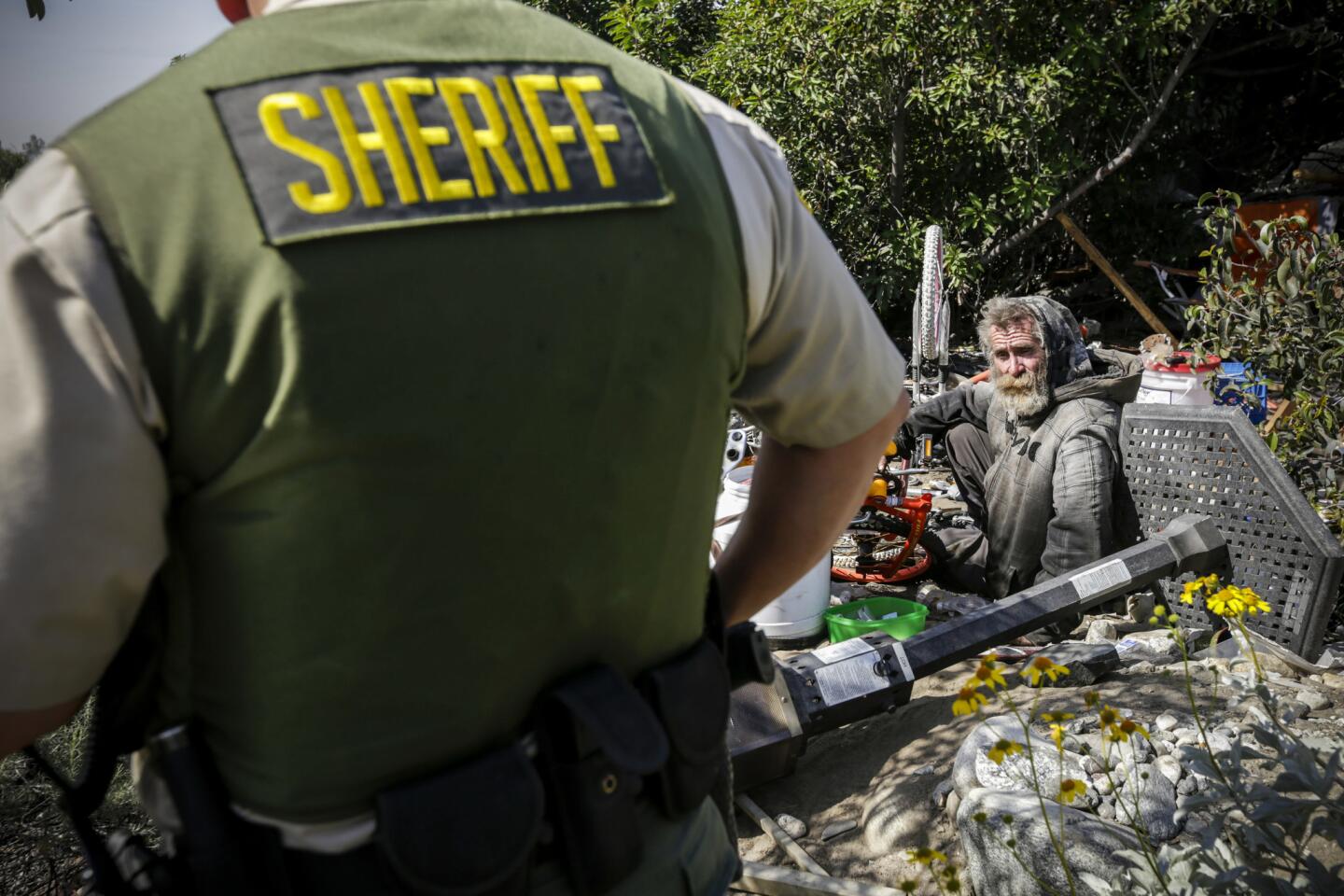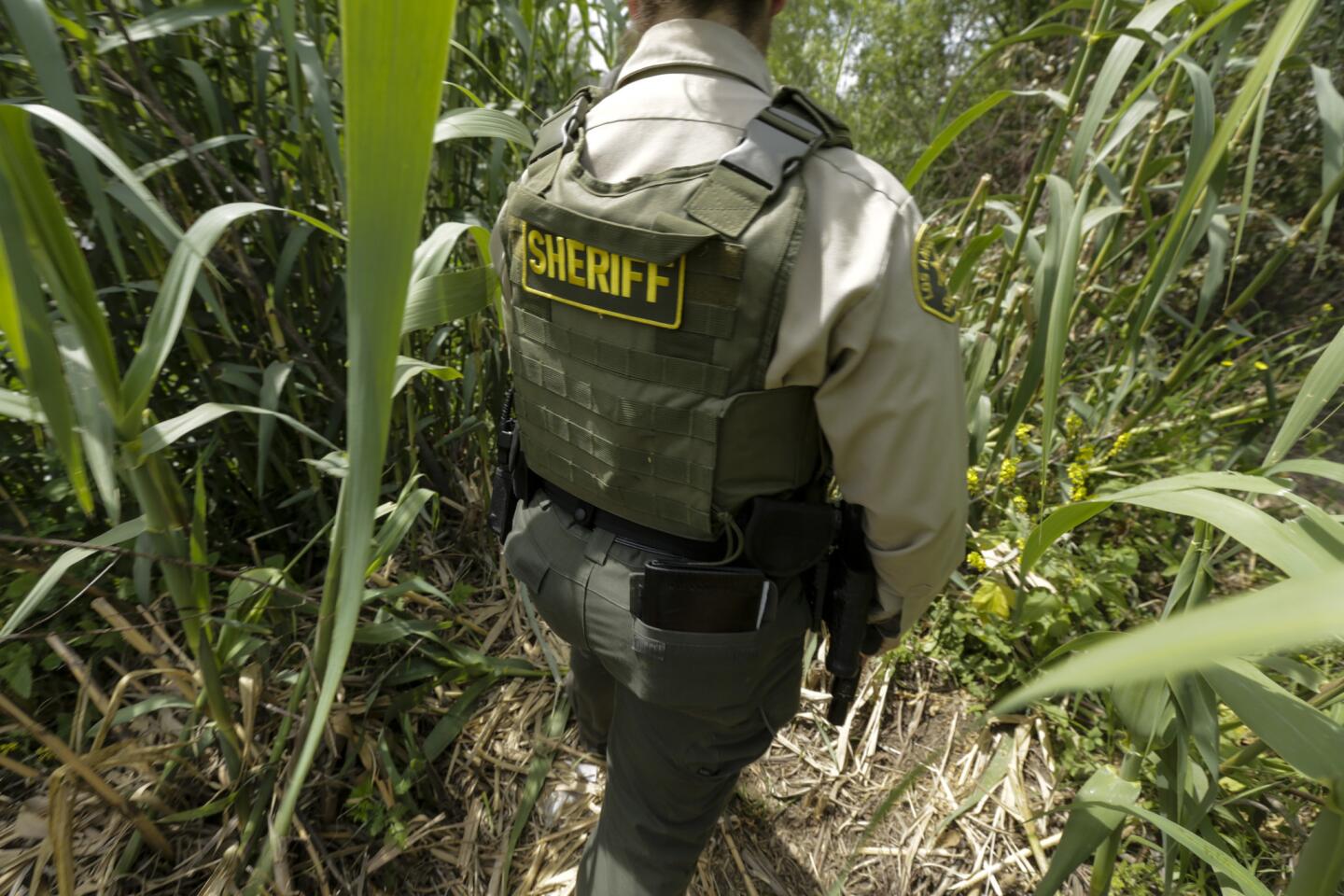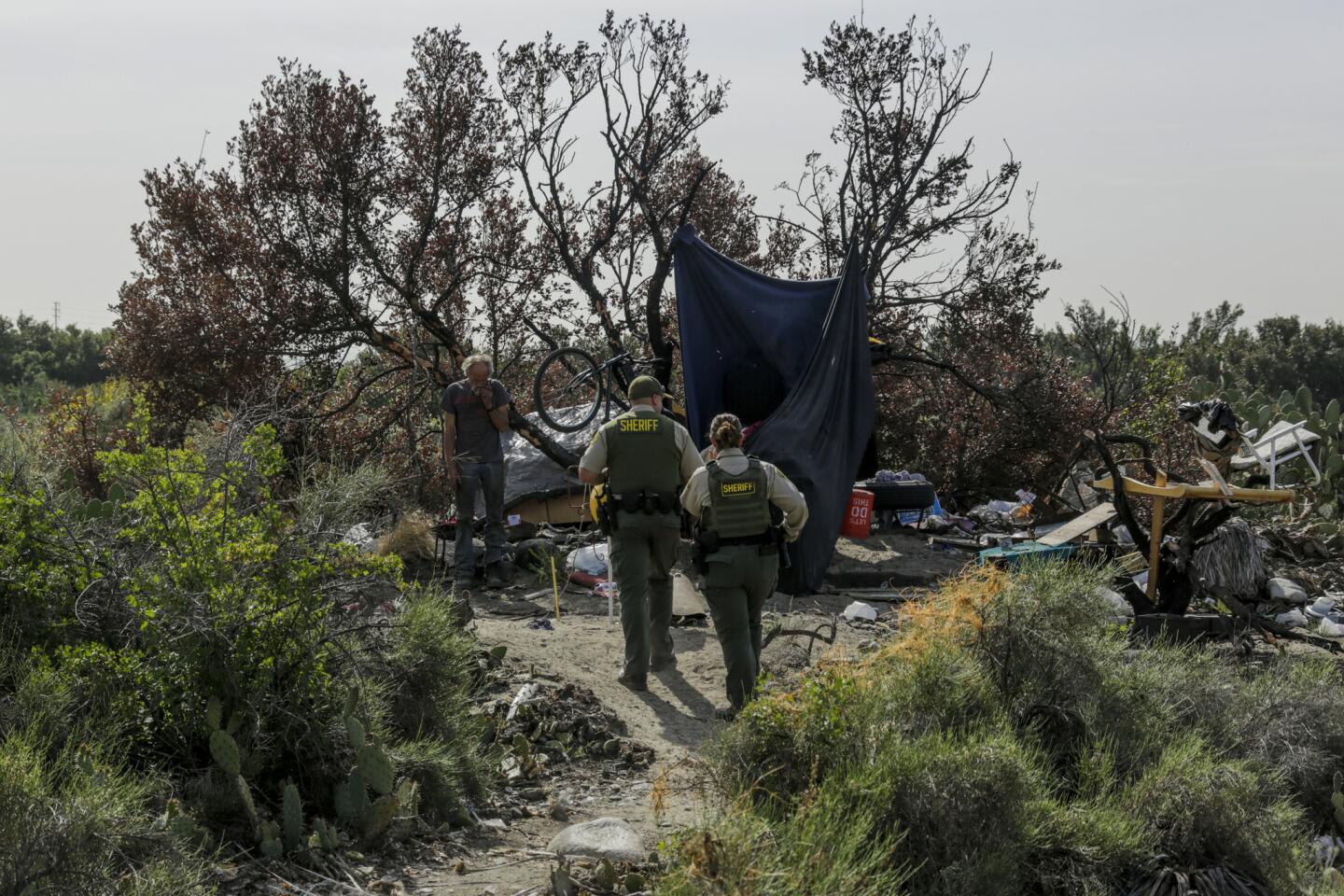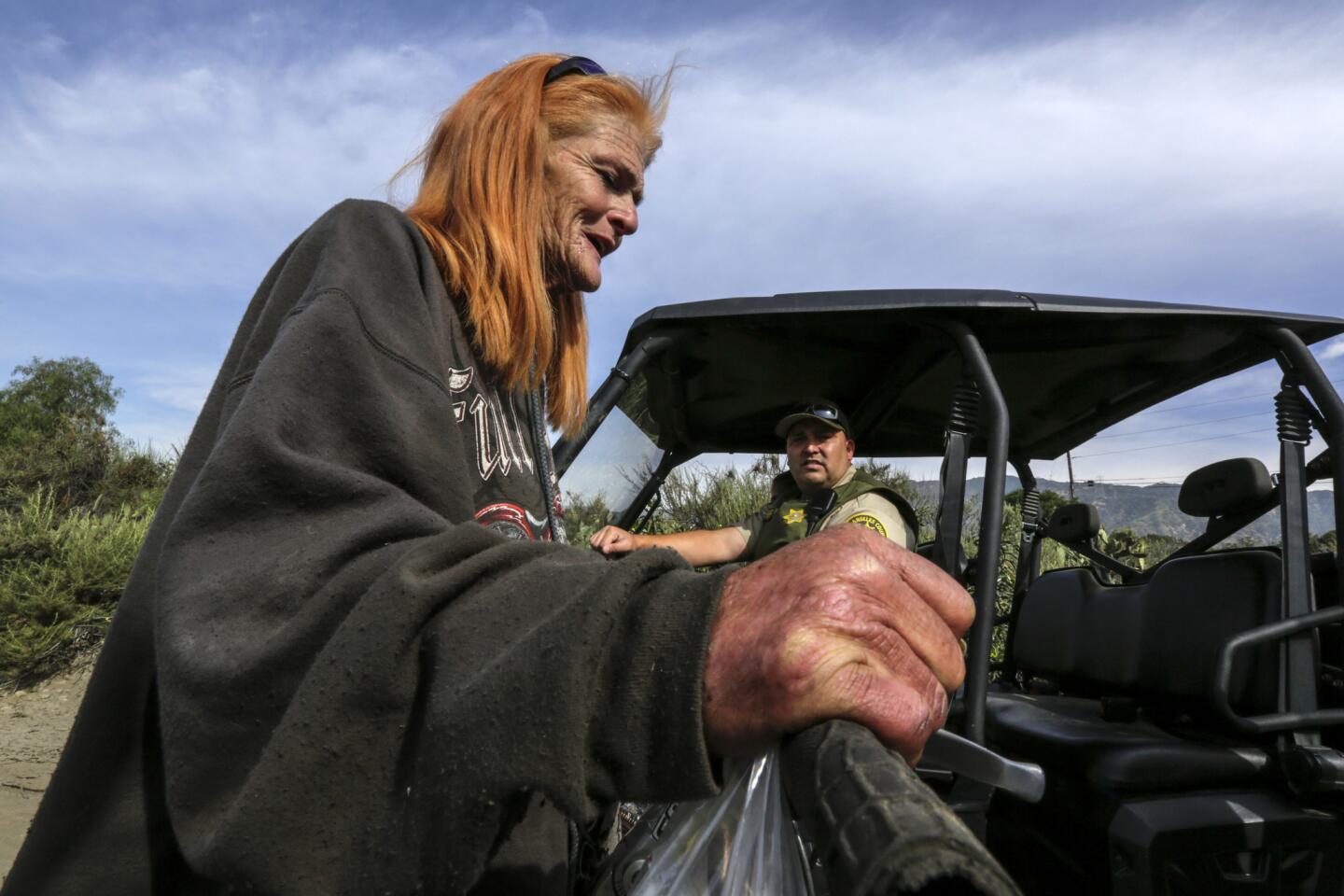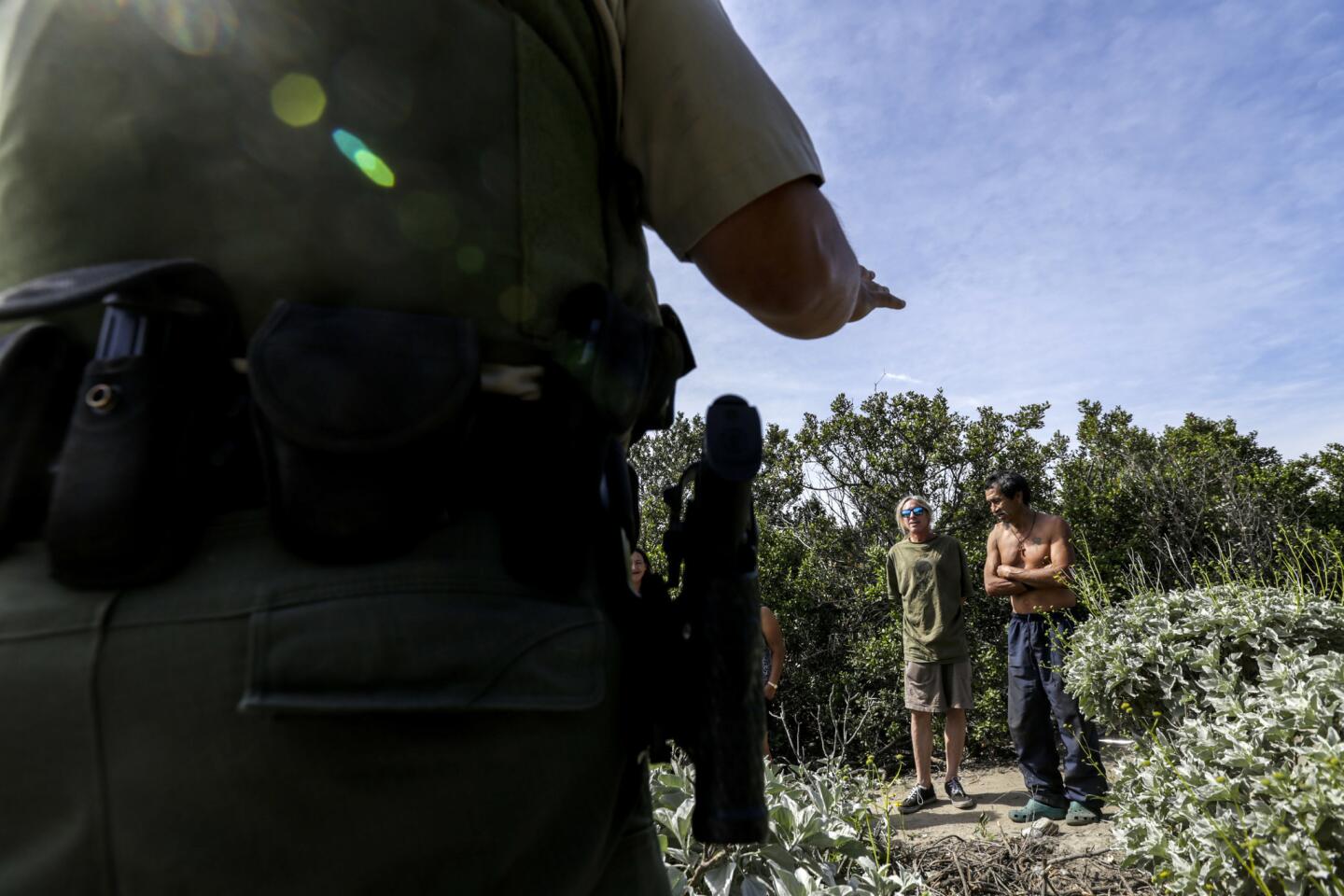With El Niño danger passed, focus shifts on homeless river dwellers
Hidden in the brush of the Santa Fe Dam basin on the San Gabriel River, the homeless camp was littered with heaps of broken furniture, disgorged computers, bicycle frames, televisions, disassembled motorcycles, pieces of exercise machines, rotting food, empty containers and half-buried clothes.
Deputies Martin Villa and Liz Aguilar approached, guns ready.
“Hello,” Villa said, leaning over a tent door. “Los Angeles County sheriffs. We’re not here to arrest anybody. We’re just here to get you some help.”
On this early April day in Irwindale, Villa was escorting a team of county social workers on a humanitarian mission. But a couple of months earlier, Villa had a harsher message.
“What’s up with you?” Villa asked, confronting two men under a bridge during a February patrol of the river. “We’ve warned you, advised you numerous times. You need to pack up your stuff and leave. We’re going to have to start enforcing and take you to jail.”
Villa’s contrasting approaches reflect a wider conflict between the goals of serving the homeless and battling the health and safety problems they cause. The tension is particularly stark in the more than 100 miles of river channels that crisscross L.A. County.
A March count by the Los Angeles Homeless Services Authority documented more than 600 people living in the San Gabriel, Rio Hondo and Los Angeles rivers and tributaries.
Largely out of sight, the camps for years attracted little public notice. But their hidden environmental costs were out of proportion to their numbers.
Last year, the county Department of Public Works conducted 19 cleanups in the San Gabriel and Rio Hondo rivers, removing 100 tons of debris and 40 containers of hazardous materials and bio-waste, according to records obtained through the Public Records Act.
In a five-day cleanup last summer in Tujunga Wash, the Los Angeles city Bureau of Sanitation removed 42 truckloads of debris at a cost of $300,000.
Then, amid a widening public awareness of homelessness, the river communities became the focus of humanitarian concern last fall with predictions of approaching El Niño storms that could fill the river channels with deadly flows.
Teams of outreach workers and law enforcement officers mobilized to visit river encampments warning people to be ready to evacuate.
At the highest levels, city and county officials adopted a public face of tolerance.
“We try to take a balanced approach,” said Gary Hildebrand, deputy director of the county Department of Public Works. “We’re trying to be sensitive to the plight these folks are in and trying to deal with them in a humane and flexible manner.”
As the El Niño deluge fizzled, patrols by the sheriff’s homeless detail continued, but the manner had flipped back to more traditional law enforcement.
On the February patrol, Villa and several other deputies found half a dozen camps that had reappeared after their predecessors were cleaned out. At every one they ordered the campers to leave and told them they’d be back to ensure they did.
By the letter of the law, all camps in the river are illegal. Unlike city sidewalks, where court rulings have established a constitutional right to keep personal property, the waterways are protected by the California Clean Water Act.
The law prohibits the introduction of trash, toxic liquids or human waste into the river system.
“The standard is zero trash,” said Samuel Unger, executive director of the Los Angeles Regional Water Control Board, the agency responsible for enforcing the Clean Water Act.
But the water board has no uniformed enforcement. It applies administrative pressure on local agencies to achieve long-term reductions of pollutants flowing into the watershed. That has principally meant building and maintaining catch systems to keep trash out of the storm drains.
Unger acknowledged that those who set up permanent camps with furniture, solar cells and electronic equipment and leave their waste in the riverbed are violating the Clean Water Act. But he could cite no formal water board rules requiring local agencies to remove camps.
In the absence of an over-arching policy, practices vary over numerous jurisdictions.
Eviction is immediate in the small portion of Tujunga Wash owned by the Mountains Recreation and Conservation Authority, a joint powers agency that has its own ordinance and prohibits overnight camping.
Ranger David Aceves patrols the area regularly and tells anyone who sets up a camp to be gone by dark.
In the city of Los Angeles, the removal of river camps is dictated more by constituent pressure than environmental issues.
We’re trying to be sensitive to the plight these folks are in and trying to deal with them in a humane and flexible manner.
— Gary Hildebrand, deputy director of the county Department of Public Works
A spokeswoman for the Bureau of Sanitation said the agency responds to requests for cleanups from individuals, business improvement districts, neighborhood councils and City Council offices.
Thus, extensive camps were dismantled last year along the Arroyo Seco where they were visible to motorists on the 110 Freeway. And in Studio City, where shopping centers and boutique businesses back up to the river channel, calls to police produce quick results.
But cleanups were rare in the less-visible stretch of the Los Angeles River in Elysian Valley, Atwater Village and Sepulveda Basin despite the presence of two dozen camps there identified in the March count.
Officer Luis Robles, on the transient detail in the LAPD’s Northeast Division, said his team doesn’t order people out of their camps.
Robles said he tries to establish a rapport with river dwellers, like other homeless people. “‘We’re not here to hassle you,’” he said he tells them. “‘We’re out here to get you some help. If you’re in need of resources, feel free to call me.’”
On Saturday, volunteers working with Friends of the Los Angeles River removed an estimated 20 tons of trash.
Portions of the river are U.S. government property. In those, the response is uneven. A spokesman for the U.S. Army Corps of Engineers said the agency teamed with the city of Azusa last year to clean up camps north of Foothill Boulevard and has conducted cleanups in Sepulveda Basin. But the string of camps in the Santa Fe Dam has escaped its notice.
A complex jurisdictional overlap confronted Villa this month when the social workers led him to the festering trash heaps there. The property is owned by the federal government but is in the city of Irwindale. The camps appeared to have been allowed to grow unchecked for years.
As promised, he did nothing but offer help.
Elsewhere in California, the response to homeless camps in protected waterways has been more decisive.
Late in 2014, San Jose removed an entrenched camp of more than 100 people from Coyote Creek running through the city’s downtown.
After years of growing frustration, the trigger for the cleanup was a complaint filed by a California Fish and Wildlife warden about damage to the creek.
The San Francisco Bay Regional Water Quality Control Board responded with a policy.
It ordered San Jose to come up with a plan to prevent the discharge of human waste into the creek.
The result was the formation of a coalition of the city, Santa Clara County and 13 water districts to enforce the environmental law.
When an encampment is found, it is posted with a warning to residents, then cleaned, said Chris Elias, deputy officer of the Santa Clara Valley Water District, which leads the effort.
“Structures will be demolished; anything that remains is taken out,” Elias said.
Park rangers then sweep the area to be sure they don’t come back.
Unger, executive director of the L.A. water quality board, said his staff is considering whether to follow the Bay Area model.
Meanwhile, rain or no rain, the safety of the camp dwellers and the health of the waterway still pose an uneasy balance of priorities when the sheriff’s team goes into the river.
On his recent patrol, Villa was gratified to find only two camps hidden in the reeds in a picturesque section of the river where ducks and herons frequent a lagoon.
“Last fall there were more than 20 camps here,” he said.
Although the initial enforcement push was to save lives, it will continue, he said, to save the river.
“After the rainy season the intention is to keep it cleaned out,” he said.
Twitter: @LATdoug
ALSO
As downtown L.A. gentrifies, Fiesta Broadway isn’t as much of a fiesta
The most influential person on the coastal commission may be this lobbyist
Official to low-income earners: If you can’t afford Costa Mesa, look somewhere else
More to Read
Sign up for Essential California
The most important California stories and recommendations in your inbox every morning.
You may occasionally receive promotional content from the Los Angeles Times.
